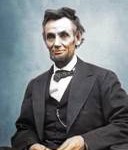 This is Part Two of a series about inauguration speeches, in particular that of Abraham Lincoln, whose bible was used by President Barack Obama for both his first and second inaugurations. It is best to read Part One here first, then come back here. [I’ll wait].
This is Part Two of a series about inauguration speeches, in particular that of Abraham Lincoln, whose bible was used by President Barack Obama for both his first and second inaugurations. It is best to read Part One here first, then come back here. [I’ll wait].
Okay, welcome back. As I noted in the previous article, Lincoln’s first inaugural address was methodical and logical. And long. Lofty inspiration it wasn’t, but that changed in his concluding peroration in which he invoked the depth of the emotion of the moment, a pleading for all men to abandon the path to civil war:
I am loath to close. We are not enemies, but friends. We must not be enemies. Though passion may have strained it must not break our bonds of affection. The mystic chords of memory, stretching from every battlefield and patriot grave to every living heart and hearthstone all over this broad land, will yet swell the chorus of the Union, when again touched, as surely they will be, by the better angels of our nature.
Four years later Lincoln’s second inaugural address was the antithesis to his first – brief, introspective, war-weary. As we have seen in the movie Lincoln with Daniel Day-Lewis, Lincoln was hard at work trying to get the 13th Amendment to the Constitution passed, an act that would effectively codify the war-time Emancipation Proclamation. In his first address he was “devoted altogether to saving the Union without war.” But still the war came. Now, at his second inauguration, Lincoln lamented that while “both parties deprecated war,” one of them “would make war rather than let the nation survive, and the other would accept war rather than let it perish.”
The sadness in his words captured the painful knowledge that over 600,000 men died during the war nearing its end, though not yet over. Lincoln ruminated over the possibility that God was allowing the war to continue as penance for the offense of slavery. While he exclaimed that “fondly do we hope, fervently do we pray, that this mighty scourge of war may speedily pass away,” he worried that:
if God wills that it continue until all the wealth piled by the bondsman’s two hundred and fifty years of unrequited toil shall be sunk, and until every drop of blood drawn with the lash shall be paid by another drawn with the sword, as was said three thousand years ago, so still it must be said “the judgments of the Lord are true and righteous altogether.”
Finally, with many in the North calling for punishment of the South during the coming reconstruction after the war, Lincoln ends with a call for constraint and compassion.
With malice toward none, with charity for all, with firmness in the right as God gives us to see the right, let us strive on to finish the work we are in, to bind up the nation’s wounds, to care for him who shall have borne the battle and for his widow and his orphan, to do all which may achieve and cherish a just and lasting peace among ourselves and with all nations.
Unfortunately for the South and North alike, Lincoln’s life was taken and a period of turmoil enveloped the nation. A period that extended at least 100 years until the efforts of Martin Luther King raised again the issues of inequality to the national discourse. And here again, on this day in which President Obama took the oath of office for his second term as President on both the King bible and the Lincoln bible, the insights of Lincoln rise once again to the forefront of the discussion. In the next part of this series I will have more on President Obama’s second inauguration speech and his references to Lincoln.
If you missed it, please take a moment to read Part 1.
More about Abraham Lincoln.
Follow me by subscribing by email on the home page. And feel free to “Like” my Facebook author’s page and connect on LinkedIn. Share with your friends using the buttons below.











Pingback: Lincoln to King to Obama: President Obama’s Second Inaugural Address Continues the Push Toward a More Perfect Union | Science Traveler
Both President Obama’s Second Inaugural and President Lincoln’s Second Inaugural demarcate into the six elements of a Euclidean proposition. Our website, http://www.thestructureofreason.com, has a demarcation of Obama’s speech. Our first book, “Abraham Lincoln and the Structure of Reason”, published by Savas Beatie in 2010, shows how Lincoln used the six elements of a proposition: enunciation, exposition, specification, construction, proof, and conclusion, in his speeches and letters, including Lincoln’s inaugural addresses. Our second book, “Barack Obama, Abraham Lincoln, and the Structure of Reason”, published by Savas Beatie in 2012, shows how President Obama began using Lincoln’s system early in 2011.
Dan Van Haften
Thanks for your great comment, Dan. I actually have a first edition of your 2010 book signed and inscribed to me by both you and David Hirsch. And I bought the second one on Barack Obama recently: https://davidjkent-writer.com/2013/03/21/recent-abraham-lincoln-book-acquisitions/
I’ll check out your website, and if you don’t mind, will write an article about it here.
Besides my book on Nikola Tesla coming out shortly I’m working on a book about Abraham Lincoln. Thanks again for dropping by my site. Hope to see you again.
Pingback: President Obama, Martin Luther King, and Abraham Lincoln’s Inauguration Addresses | Science Traveler